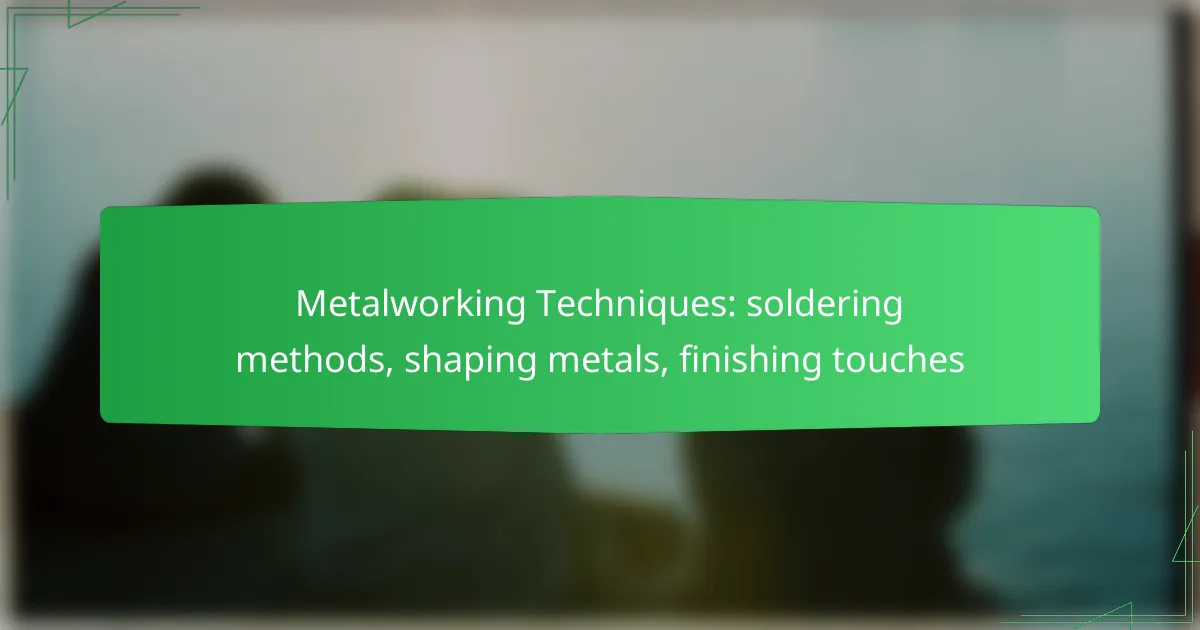Metalworking encompasses a variety of techniques that enhance the properties and appearance of metals, including soldering methods, shaping processes, and finishing touches. Effective soldering techniques like TIG and MIG welding are crucial for creating strong joints, while shaping methods such as forging and rolling allow for precise manipulation of metal forms. Finally, applying finishing touches through polishing and surface treatments elevates the quality and durability of the final product.

What are the best soldering methods for metalworking?
The best soldering methods for metalworking include techniques like TIG welding, MIG welding, and others, each suited for specific applications. Choosing the right method depends on factors such as the materials involved, the desired strength of the joint, and the working environment.
TIG welding
TIG welding, or Tungsten Inert Gas welding, is a precise method that uses a non-consumable tungsten electrode to produce the weld. It is ideal for thin materials and provides high-quality, clean welds, making it popular in industries like aerospace and automotive.
Consider using TIG welding for applications requiring strong, aesthetically pleasing joints. However, it requires skill and can be slower than other methods, so practice is essential for achieving optimal results.
MIG welding
MIG welding, or Metal Inert Gas welding, utilizes a continuous wire feed as an electrode and an inert gas to shield the weld from contamination. This method is versatile and suitable for various materials, including steel and aluminum, making it a favorite among hobbyists and professionals alike.
One advantage of MIG welding is its speed, allowing for quick production. However, it may not provide the same level of control as TIG welding, especially on thinner materials, so it’s important to adjust settings accordingly.
Flux-cored arc welding
Flux-cored arc welding (FCAW) is similar to MIG welding but uses a tubular wire filled with flux, which eliminates the need for external shielding gas. This method is effective for outdoor applications and in windy conditions, making it a practical choice for construction and repair work.
FCAW can produce strong welds quickly, but it may generate more spatter and require additional cleanup. Ensure proper ventilation when using this method, as it can produce harmful fumes.
Oxy-fuel welding
Oxy-fuel welding involves burning a fuel gas, typically acetylene, with oxygen to create a high-temperature flame for melting metals. This traditional method is effective for welding and cutting various metals, including steel and copper.
While oxy-fuel welding is versatile and can be used in remote locations, it requires careful handling of gases and equipment. Proper safety measures are essential to prevent accidents, such as ensuring adequate ventilation and using protective gear.
Resistance welding
Resistance welding uses electrical resistance to generate heat and join metal pieces together. This method is commonly used in manufacturing processes, such as automotive assembly, due to its speed and efficiency.
Resistance welding is ideal for joining thin sheets of metal and can produce strong, consistent welds. However, it may not be suitable for thicker materials or complex shapes, so evaluate the specific requirements of your project before choosing this method.

How to shape metals effectively?
Shaping metals effectively involves various techniques that manipulate the material into desired forms while maintaining structural integrity. Key methods include forging, rolling, extrusion, and stamping, each offering unique advantages depending on the application and material type.
Forging techniques
Forging is a process that involves shaping metal using compressive forces, typically applied through hammers or presses. This technique enhances the metal’s strength and durability by aligning its grain structure. Common forging methods include open-die forging, closed-die forging, and drop forging, each suitable for different shapes and sizes.
When considering forging, it’s essential to select the right temperature for the metal, as this affects its malleability. For example, steel is often forged at temperatures ranging from 1,100°C to 1,300°C, while aluminum requires lower temperatures around 400°C to 500°C.
Rolling processes
Rolling processes involve passing metal through a pair of rolls to reduce thickness or shape it into flat sheets or profiles. This method can be performed hot or cold, with hot rolling typically used for larger, bulk shapes and cold rolling for precision applications. The choice of rolling process can significantly impact the final properties of the metal.
In practice, hot rolling is often preferred for its ability to produce larger sections, while cold rolling offers tighter tolerances and improved surface finishes. For instance, cold-rolled steel sheets are commonly used in automotive and appliance manufacturing due to their superior surface quality.
Extrusion methods
Extrusion is a shaping process where metal is forced through a die to create long shapes with a constant cross-section. This technique is particularly effective for producing complex profiles and is widely used for materials like aluminum and copper. The extrusion process can be done hot or cold, influencing the material’s final properties.
When extruding, consider the die design and material flow, as these factors affect the quality of the finished product. For example, aluminum extrusions are often used in construction and automotive industries due to their lightweight and strength characteristics.
Stamping operations
Stamping operations involve pressing metal sheets into specific shapes using a die. This method is efficient for mass production and can create intricate designs with high precision. Stamping is commonly used for components in the automotive and electronics industries, where consistency and accuracy are crucial.
Key considerations in stamping include material thickness, die design, and the type of press used. For instance, progressive stamping allows for multiple operations in a single press cycle, significantly increasing production speed and reducing costs.

What finishing touches enhance metalwork?
Finishing touches in metalwork significantly improve the aesthetic and functional qualities of the final product. Techniques such as polishing, coating, surface treatments, and deburring are essential for achieving a professional look and durability.
Polishing techniques
Polishing techniques involve using abrasives to create a smooth, reflective surface on metal items. Common methods include using polishing compounds with buffing wheels or hand-held tools, which can achieve different levels of shine depending on the grit used.
For best results, start with a coarser grit to remove imperfections, then gradually move to finer grits. Always clean the surface between grits to avoid scratches from residual particles.
Coating options
Coating options protect metal surfaces from corrosion and wear while enhancing appearance. Popular choices include powder coating, which provides a durable finish, and anodizing, particularly for aluminum, which increases resistance to corrosion and wear.
When selecting a coating, consider the environment the metal will be exposed to, as some coatings are better suited for outdoor use while others may be ideal for indoor applications. Always follow the manufacturer’s guidelines for application and curing times.
Surface treatments
Surface treatments modify the properties of metal surfaces to improve performance. Techniques like galvanizing, which involves coating steel with zinc, provide excellent corrosion resistance, while heat treatment can enhance strength and hardness.
Evaluate the specific needs of your project when choosing a surface treatment. For instance, if the metal will be exposed to moisture, galvanizing may be preferable, while heat treatment is suitable for tools and structural components requiring high strength.
Deburring methods
Deburring methods remove sharp edges and irregularities from metal parts, enhancing safety and functionality. Common techniques include manual filing, using deburring tools, or employing mechanical processes like tumbling or sanding.
To ensure thorough deburring, inspect all edges and surfaces after the initial process. It’s advisable to use a combination of methods for complex shapes to achieve a smooth finish and prevent potential injuries during handling.

What tools are essential for metalworking?
Essential tools for metalworking include welding machines, metal lathes, angle grinders, and drill presses. Each tool serves a specific purpose, enabling various techniques for shaping, joining, and finishing metal components.
Welding machines
Welding machines are crucial for joining metal pieces through melting and fusing. Common types include MIG, TIG, and stick welders, each suited for different materials and thicknesses. For instance, MIG welding is often preferred for its speed and ease of use, making it ideal for beginners.
When selecting a welding machine, consider the power output, type of welding required, and the materials you’ll be working with. Ensure you have proper safety gear, such as gloves and a welding helmet, to protect against sparks and UV radiation.
Metal lathes
Metal lathes are used to shape metal by rotating the workpiece against cutting tools. They allow for precise shaping, drilling, and threading of metal components. A good lathe can handle various materials, including steel, aluminum, and brass.
When using a lathe, ensure that the workpiece is securely mounted and that you select the appropriate cutting speed based on the material. Regular maintenance, such as lubrication and checking for wear, will enhance the lathe’s performance and longevity.
Angle grinders
Angle grinders are versatile tools used for cutting, grinding, and polishing metal surfaces. They come with various attachments, such as cutting discs and grinding wheels, allowing for different applications. A 4.5-inch grinder is commonly used for most metalworking tasks.
When operating an angle grinder, always wear protective gear, including safety glasses and gloves. Be mindful of the tool’s weight and balance, as improper handling can lead to accidents. Regularly check the condition of the discs to ensure safe and effective operation.
Drill presses
Drill presses provide precise drilling capabilities for metalworking projects. They offer better control and accuracy compared to handheld drills, making them ideal for creating consistent holes in metal. Look for a drill press with adjustable speed settings to accommodate different materials.
When using a drill press, secure the workpiece firmly to prevent movement during drilling. Use the correct drill bit for the metal type, and consider using cutting fluid to reduce friction and heat. Regular maintenance, such as cleaning and lubrication, will keep the drill press in optimal condition.
